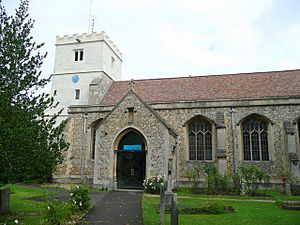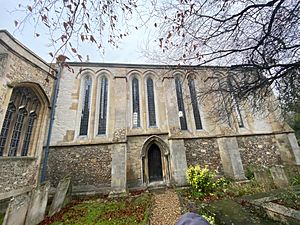St Andrew's Church, Cherry Hinton facts for kids
Quick facts for kids St Andrew’s Church, Cherry Hinton |
|
|---|---|

St Andrew’s Church, Cherry Hinton
|
|
| 52°11′31″N 0°10′41″E / 52.19194°N 0.17806°E | |
| OS grid reference | TL 48971 57096 |
| Location | St Andrew’s Church High Street, Cherry Hinton, Cambridge |
| Country | England |
| Denomination | Church of England |
| History | |
| Status | Active |
| Architecture | |
| Functional status | Parish church |
| Heritage designation | Grade I listed |
| Style | Gothic |
| Administration | |
| Archdeaconry | Archdeaconry of Cambridge |
| Diocese | Diocese of Ely |
St Andrew's Church in Cherry Hinton is a historic church located in Cambridge, England. It is part of the Church of England and serves as a local parish church. This building is very important, listed as Grade I, which means it has special historical or architectural significance.
The church was first built in the late 1100s. Its chancel, the area around the altar, was added in the 1200s. Builders used local materials like flint, clunch, and Barnack stone to construct it.
Church History
The church has a long and interesting past. In the 1300s, a person named Simon Langham was the Bishop of Ely. He was a big supporter of Peterhouse, Cambridge, which is one of the colleges at Cambridge University. Bishop Langham gave the rectory (the church's property and income) of Cherry Hinton to Peterhouse College.
Later, in 1880, the church building was carefully restored and rebuilt. This work was done by an architect named George Gilbert Scott Jr.. The chancel area was also restored a few years later, in 1886, by John Thomas Micklethwaite.
As the area around Cherry Hinton grew, a new church was needed. So, in 1891, a "daughter church" called St John the Evangelist's was built. It was created to serve the new homes being built between Hills Road and Cherry Hinton Road.
Church Architecture
The chancel of St Andrew's Church is a beautiful example of Early English Gothic architecture. It was built around 1230-1250 and has smooth stone walls. You can see pairs of tall, narrow windows called lancet windows. These windows are typical of the Early English style.
The large window at the east end of the church was changed later, during the early Tudor period. It was replaced with a five-light window in the Perpendicular style, which is another type of Gothic architecture.
The church tower also has the Perpendicular style, with its straight lines and tall windows. However, you can still see parts of its older, Norman origins in the arches inside. One of the bells in the tower is very old, dating back to the 1300s. It is the oldest bell in the city of Cambridge.
Inside the tower, there is a special coffin-shaped stone tablet. It was made by a famous sculptor named John Flaxman and honors Captain Serocold, who passed away in 1794.


